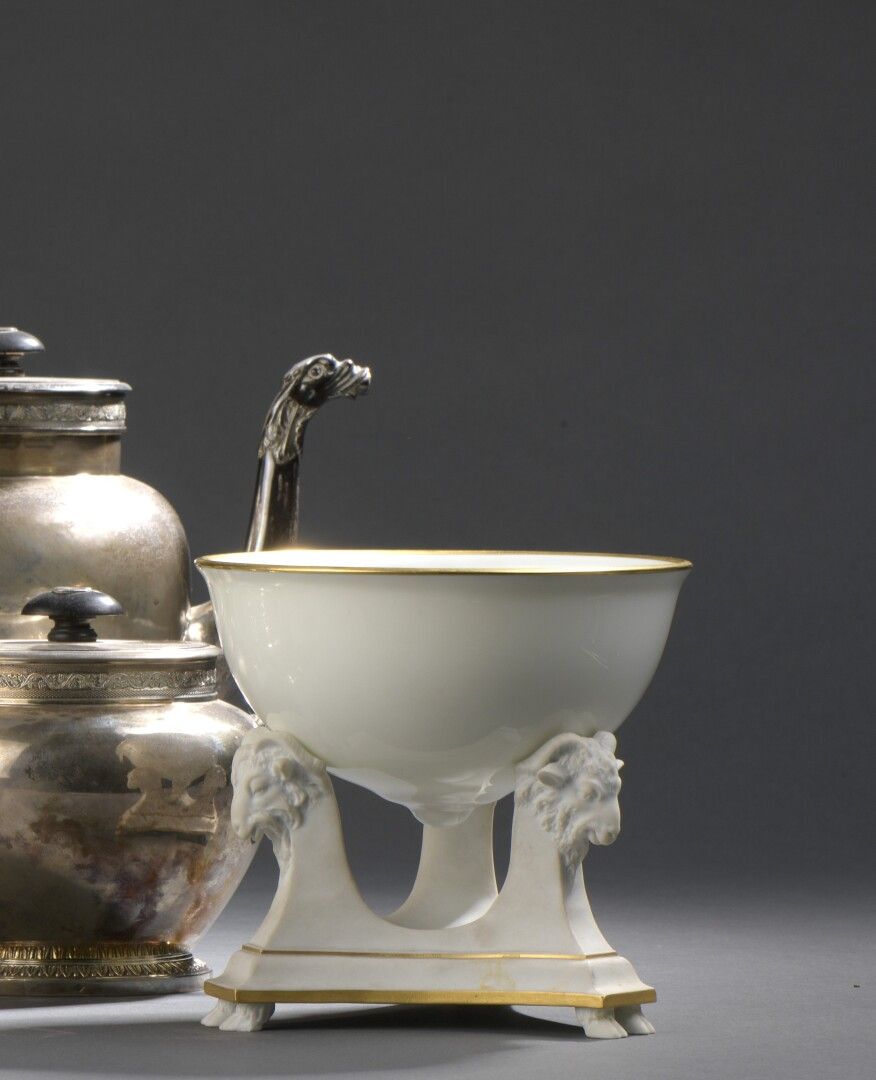Description
White porcelain breast bowl (or "jatte-téton") with gold fillets, resting on a tripod biscuit base decorated with goats' heads and gold fillets. Small feet in the shape of deer legs. Manufacture nationale de Sèvres, 2003. Marks in hollow with the date of 2003 and mark with the red stamp of the manufacture. Reissue of the 1787 model by Jean-Jacques Lagrenée le Jeune and Louis-Simon Boizot. Two very small chips on the feet. H. 11,5 D. 13,5 cm. History Between 1785 and 1787, King Louis XVI had a dairy built at the Château de Rambouillet where Queen Marie-Antoinette "could come and refresh herself with fresh milk", as she did at the hamlet of Trianon. To consume them, a service was ordered from the Royal Manufacture of Sevres. It was designed and produced by the most renowned artists at Sèvres: Louis Simon Boizot (1743-1809), head of the sculpture workshop, and the painter Jean-Jacques Lagrenée le Jeune (1739-1821). The service was originally intended to have 108 pieces, but only 65 were delivered in 1787 and again in 1788. This incredible object was used to drink milk, a symbol of fertility and above all of a bucolic life that allowed Marie-Antoinette to forget the strict etiquette of the Court. According to legend, the shape of the teat cup was obtained by moulding the royal breast. The shape is actually inspired by the ancient drinking cup in the shape of a breast, the mastos, used in Greek banquets, the symposions.
62
White porcelain breast bowl (or "jatte-téton") with gold fillets, resting on a tripod biscuit base decorated with goats' heads and gold fillets. Small feet in the shape of deer legs. Manufacture nationale de Sèvres, 2003. Marks in hollow with the date of 2003 and mark with the red stamp of the manufacture. Reissue of the 1787 model by Jean-Jacques Lagrenée le Jeune and Louis-Simon Boizot. Two very small chips on the feet. H. 11,5 D. 13,5 cm. History Between 1785 and 1787, King Louis XVI had a dairy built at the Château de Rambouillet where Queen Marie-Antoinette "could come and refresh herself with fresh milk", as she did at the hamlet of Trianon. To consume them, a service was ordered from the Royal Manufacture of Sevres. It was designed and produced by the most renowned artists at Sèvres: Louis Simon Boizot (1743-1809), head of the sculpture workshop, and the painter Jean-Jacques Lagrenée le Jeune (1739-1821). The service was originally intended to have 108 pieces, but only 65 were delivered in 1787 and again in 1788. This incredible object was used to drink milk, a symbol of fertility and above all of a bucolic life that allowed Marie-Antoinette to forget the strict etiquette of the Court. According to legend, the shape of the teat cup was obtained by moulding the royal breast. The shape is actually inspired by the ancient drinking cup in the shape of a breast, the mastos, used in Greek banquets, the symposions.
